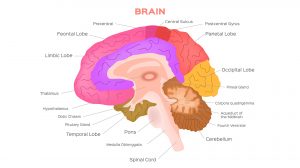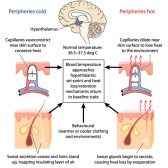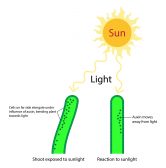Table of Contents
Definition
noun
plural: ribonucleotides
ri·bo·nu·cle·o·tide, ˌraɪbəʊˈnjuːklɪəˌtaɪd
A form of nucleotide in which the sugar component is a ribose (as opposed to deoxyribonuleotide that has a deoxyribose as its sugar)
Details
Overview
A nucleotide is regarded as the basic building block of nucleic acids (e.g. DNA and RNA). A nucleic acid is one of the major groups of biomolecules others are carbohydrates (especially, polysaccharides), proteins, and amino acids. Nucleic acids are involved in the preservation, replication, and expression of hereditary information. The fundamental structure of a nucleotide is a nitrogenous base, a pentose sugar, and phosphate group(s). Based on the pentose sugar component, the nucleotide may either be a ribose or a deoxyribose. Nucleotides with a ribose sugar make up the RNA whereas those with a deoxyribose make up the DNA molecule.
Structure/Characteristics
A ribonucleotide is a nucleotide that has a ribose as its sugar component. As for the nitrogenous base (or nucleobase) component, the common bases are adenine (A), guanine (G), cytosine (C), and uracil (U). Depending on the number of phosphates that make up the compound, the ribonucleotide may be designated as monophosphate (having only one phosphate group), diphosphate (having two phosphate groups), and triphosphate (having three phosphate groups). Thus, the common ribonucleotides include the following:
- adenosine monophosphate (AMP)
- adenosine diphosphate (ADP)
- adenosine triphosphate (ATP)
- guanosine monophosphate (GMP)
- guanosine diphosphate (GDP)
- guanosine triphosphate (GTP)
- cytidine monophosphate (CMP)
- cytidine diphosphate (CDP)
- cytidine triphosphate (CTP)
- uridine monophosphate (UMP)
- uridine diphosphate (UDP)
- uridine triphosphate (UTP)
Without the phosphate group(s), the compound is referred to as a nucleoside (i.e. a nucleobase + pentose sugar)
Common biological reactions
Common biological reactions
The ribonucleotides are biosynthesized via the de novo pathway. They may also be derived by recycling via the salvage pathway. Purines, such as adenine and guanine nucleotides, are derived from the nucleotide inosine monophosphate (IMP) since purines are synthesized as ribonucleotides and not as free nucleobases (as opposed to pyrimidines that are synthesized first as a free base). IMP, in turn, is produced from a pre-existing ribose phosphate that forms mainly from the amino acids glycine, glutamine, and aspartic acid. Ribose 5-phosphate reacts with ATP to produce 5-Phosphoribosyl-1-pyrophosphate (PRPP). PRRP has a role in both purine and pyrimidine synthesis; it is also involved in NAD and NADP formation and salvage pathways. PRRP though becomes committed particularly to purine biosynthesis when PRRP is converted into 5-phosphoribosyl amine by having the pyrophosphate of PRRP replaced by the amide group of glutamine. In humans, the biosynthesis of purines occurs in the cytosol of the liver cell. IMP is then converted into either adenosine monophosphate (AMP) or guanosine monophosphate (GMP).
As for pyrimidines such as uracil and cytosine nucleotides, the biosynthesis involves a series of steps that begins in the formation of carbamoyl phosphate. First, carbamoyl phosphate is produced from biochemical reaction involving bicarbonate, glutamine, ATP (for phosphorylation), and water molecule. The enzyme that catalyzes the reaction is carbamoyl phosphate synthetase II located in the cytosol. Next, the carbamoyl phosphate is converted into carbamoyl aspartate by the enzyme aspartate transcarbamylase. Then, the ring closes through intramolecular condensation, converting carbamoyl phosphate into dihydroorotate by the enzyme dihydroorotase. Lastly, the dihydroorotate is oxidized by dihydroorotate dehydrogenase (an integral membrane protein in the inner mitochondrial membrane) to convert into orotate. As a result, C2 of the pyrimidine ring comes from the bicarbonate ion (HCO3–), N3 comes from glutamine, and the rest of the atoms in the rings are derived from aspartate. After the pyrimidine ring forms, 5-phospho-α-D-ribosyl 1-pyrophosphate (PRPP), a ribose phosphate, reacts to orotate to form orotidine-5-monophosphate (OMP). OMP is then decarboxylated by the enzyme OMP decarboxylase to yield uridine monophosphate (UMP). Eventually, uridine diphosphate (UDP) and uridine triphosphate (UTP) are produced down the biosynthetic pathway by kinases and dephosphorylation of ATPs. UTP can be converted into cytidine triphosphate (CTP) by amination of UTP via the enzyme CTP synthetase. In humans, pyrimidines are synthesized in various tissues, especially in spleen, thymus, and gastrointestinal tract.
Common biological reactions
Purines guanine and adenine may be degraded as follows:
- Guanine (via guanase) » xanthine (via xanthine oxidase) » uric acid
- Adenosine »» inosine (via purine nucleoside phosphorylase) » hypoxanthine (via xanthine oxidase) » xanthine (via xanthine oxidase) » uric acid
In humans and other vertebrates, the exogenous purines are degraded in the liver. As a result of purine degradation, uric acid is produced as a waste product. The uric acid is released from the liver into the bloodstream through which it reaches the kidney. It is then excreted from the body via the urine.
Purines from catabolism may be salvaged and re-used as follows:
- Adenine is salvaged by the enzyme adenine phosphoribosyltransferase (APRT)
- Guanine and hypoxanthine are salvaged by the enzyme hypoxanthine-guanine phosphoribosyltransferase (HGPRT)
Pyrimidines that are degraded may also be recycled by a salvage pathway. Nucleobases are recovered for re-use post-RNA and DNA degradations. Pyrimidine salvage pathways are as follows:
Biological importance
Ribonucleotides may serve as the basic building blocks of RNA. They may also be precursors to deoxyribonucleotides when the ribonucleotides are reduced by the enzyme ribonucleotide reductase. Deoxyribonucleotides, in turn, are essential in being the basic building blocks of DNA. Apart from their involvement in nucleic acid biosynthesis, ribonucleotides are also used in cell regulation and cell signaling (e.g. adenosine monophosphate or AMP). AMP, in particular, may be phosphorylated to be converted into adenosine triphosphate (ATP), which is the cell’s major energy source. ATP contains a large amount of chemical energy stored in its high-energy phosphate bonds. It releases energy when it is broken down (hydrolyzed) into ADP (adenosine diphosphate). The energy is used for many metabolic processes. Hence, ATP is considered as the universal energy currency for metabolism. Its functions are for intracellular energy transport for various metabolic processes including biosynthetic reactions, motility, and cell division.
Supplementary
Etymology
- ribo (denotes ribose) + nucleo– (“nucleus”) + –ide (chemical suffix)
Further reading
Compare
See also
© Biology Online. Content provided and moderated by Biology Online Editors







